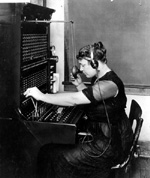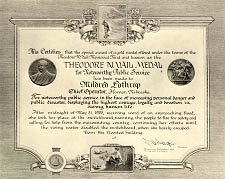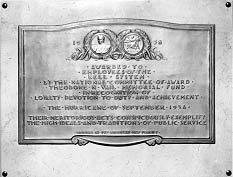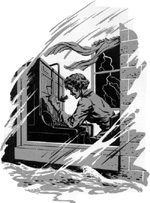
Image of Mildred Lothrop at her switchboard (THG file photo)
Telecom Heroes
Mildred Lothrop
Mildred Lothrop was the first Vail Gold Medal

Definition
The Vail Medal
The Vail Medal was created in 1920 in memory of Theodore N. Vail (President of the American Telephone and Telegraph Company from 1907 to 1919) to perpetuate his ideals of service to the public. The medal, which bears his likeness, was awarded to individuals for noteworthy acts reflecting the Bell System's highest traditions of loyalty and devotion to duty.
Adolph Alexander Weinman, one of the leading sculptors in the United States, designed the Vail Medal in 1921. In designing the medal, Mr. Weinman captured not only the personality of Vail, but also his ideals of service to the public.
The face of the medal bears a portrait of Vail, while on the reverse, the central figure represents the "Civilizing Force of Communication" speeding the winged message along the wires. At the right, "Loyalty to Service" upholds the left hand of the central figure, while a third figure, "Devotion to Duty," helps to support the lines of communication.
 There are three types of Vail Medals: bronze, silver, and gold. Bronze medals were awarded to individuals in each Bell System company by that company's awards committee. A Bell System Committee then reviewed these cases and selected those of "especially outstanding excellence or importance" for silver or gold medal awards.
There are three types of Vail Medals: bronze, silver, and gold. Bronze medals were awarded to individuals in each Bell System company by that company's awards committee. A Bell System Committee then reviewed these cases and selected those of "especially outstanding excellence or importance" for silver or gold medal awards.
A bronze medal was also awarded to groups of employees where the noteworthy act was due to the concerted action of the group, rather than by an individual.
An embossed citation certificate, with a brief description of the circumstances that occasioned the award, was given to each Vail Medal recipient. (The one pictured is Millie Lothrop's.) A bronze plaque commemorating the act was presented to the company concerned. These plaques were designed for display in telephone buildings as a permanent and public memorial. Plaques may be seen to this day in telephone company buildings across the nation.
 Up to the breakup of the Bell System in 1984, hundreds of awards were made to telephone company employees who embodied the ideal of service (see Heroes for some representative stories). Men and women of the Bell System performed acts of public service and bravery ranging from struggling through a blizzard to fix a downed line; saving a child from a burning building or a man from a raging flood; to staying at the switchboard while bullets flew—and were celebrated with the award of a Vail medal.
Up to the breakup of the Bell System in 1984, hundreds of awards were made to telephone company employees who embodied the ideal of service (see Heroes for some representative stories). Men and women of the Bell System performed acts of public service and bravery ranging from struggling through a blizzard to fix a downed line; saving a child from a burning building or a man from a raging flood; to staying at the switchboard while bullets flew—and were celebrated with the award of a Vail medal.
Mrs. Lothrop, Northwestern Bell chief operator, lived with her five sons in the one-story building that housed the central office in Homer, Nebraska. She was awakened early in the morning of May 31, 1920, by a signal at the switchboard. A subscriber, who lived about five miles up the valley above Homer, said there had been a cloudburst and the whole valley was a sheet of water.
Millie immediately called the fire chief and began calling other subscribers, impressing upon them the danger. She sent her youngest son out into the water to ring the fire bell, knowing that many would call the central office to find out why the bell was ringing.

A sketch of the same (from For Noteworthy Public Service)
Twenty years later, almost to the day, another flood threatened Homer in the early morning hours of June 4, 1940. Once again, Millie Lothrop remained at her switchboard, warning inhabitants and directing the work of rescuing those she knew to be trapped by rising water.
Residents of the community, remembering her courage and resourcefulness during the previous flood, called on her for help and depended on her to contact and help rescue those in danger. The rushing waters nearly reached the second floor of the building where the switchboard was located, but she stayed at the board for the many hours it took until the flood receded. The community credited the saving of many lives to Millie’s resourcefulness and courage.
Twice, she had risked her life to save others. According to James C. Rippey, in Goodbye Central, Hello World, Millie admitted to being frightened, “But at times like that, you just don’t think about yourself.”
Telecom Heroes
Mildred Lothrop

Image of Mildred Lothrop at her switchboard (THG file photo)
Mildred Lothrop was the first Vail Gold Medal


Definition
The Vail Medal
The Vail Medal was created in 1920 in memory of Theodore N. Vail (President of the American Telephone and Telegraph Company from 1907 to 1919) to perpetuate his ideals of service to the public. The medal, which bears his likeness, was awarded to individuals for noteworthy acts reflecting the Bell System's highest traditions of loyalty and devotion to duty.
Adolph Alexander Weinman, one of the leading sculptors in the United States, designed the Vail Medal in 1921. In designing the medal, Mr. Weinman captured not only the personality of Vail, but also his ideals of service to the public.
The face of the medal bears a portrait of Vail, while on the reverse, the central figure represents the "Civilizing Force of Communication" speeding the winged message along the wires. At the right, "Loyalty to Service" upholds the left hand of the central figure, while a third figure, "Devotion to Duty," helps to support the lines of communication.
 There are three types of Vail Medals: bronze, silver, and gold. Bronze medals were awarded to individuals in each Bell System company by that company's awards committee. A Bell System Committee then reviewed these cases and selected those of "especially outstanding excellence or importance" for silver or gold medal awards.
There are three types of Vail Medals: bronze, silver, and gold. Bronze medals were awarded to individuals in each Bell System company by that company's awards committee. A Bell System Committee then reviewed these cases and selected those of "especially outstanding excellence or importance" for silver or gold medal awards.
A bronze medal was also awarded to groups of employees where the noteworthy act was due to the concerted action of the group, rather than by an individual.
An embossed citation certificate, with a brief description of the circumstances that occasioned the award, was given to each Vail Medal recipient. (The one pictured is Millie Lothrop's.) A bronze plaque commemorating the act was presented to the company concerned. These plaques were designed for display in telephone buildings as a permanent and public memorial. Plaques may be seen to this day in telephone company buildings across the nation.
 Up to the breakup of the Bell System in 1984, hundreds of awards were made to telephone company employees who embodied the ideal of service (see Heroes for some representative stories). Men and women of the Bell System performed acts of public service and bravery ranging from struggling through a blizzard to fix a downed line; saving a child from a burning building or a man from a raging flood; to staying at the switchboard while bullets flew—and were celebrated with the award of a Vail medal.
Up to the breakup of the Bell System in 1984, hundreds of awards were made to telephone company employees who embodied the ideal of service (see Heroes for some representative stories). Men and women of the Bell System performed acts of public service and bravery ranging from struggling through a blizzard to fix a downed line; saving a child from a burning building or a man from a raging flood; to staying at the switchboard while bullets flew—and were celebrated with the award of a Vail medal.
Mrs. Lothrop, Northwestern Bell chief operator, lived with her five sons in the one-story building that housed the central office in Homer, Nebraska. She was awakened early in the morning of May 31, 1920, by a signal at the switchboard. A subscriber, who lived about five miles up the valley above Homer, said there had been a cloudburst and the whole valley was a sheet of water.
Millie immediately called the fire chief and began calling other subscribers, impressing upon them the danger. She sent her youngest son out into the water to ring the fire bell, knowing that many would call the central office to find out why the bell was ringing.
Although the mayor and her remaining sons urged her to abandon her switchboard, she would not leave until the water rose so high the board would no longer function. As she left, the water was up to her shoulders and the current was very swift. She was unsure of the location of four of her sons, but when morning came, they were all found alive and unharmed.
Twenty years later, almost to the day, another flood threatened Homer in the early morning hours of June 4, 1940. Once again, Millie Lothrop remained at her switchboard, warning inhabitants and directing the work of rescuing those she knew to be trapped by rising water.

A sketch of the same (from For Noteworthy Public Service)
Residents of the community, remembering her courage and resourcefulness during the previous flood, called on her for help and depended on her to contact and help rescue those in danger. The rushing waters nearly reached the second floor of the building where the switchboard was located, but she stayed at the board for the many hours it took until the flood receded. The community credited the saving of many lives to Millie’s resourcefulness and courage.
Twice, she had risked her life to save others. According to James C. Rippey, in Goodbye Central, Hello World, Millie admitted to being frightened, “But at times like that, you just don’t think about yourself.”
back to top
back to Lewis H. Latimer
on to Jack A. MacAllister